Supertest: German Premium Tier VI Aircraft Carrier Erich Loewenhardt (Updated)
7 min readThe Erich Loewenhardt is based on an early design of the Graf Zeppelin-class of aircraft carrier that was planned as part of the Plan Z of the Kriegsmarine.
In the mid-1930s, Germany started the Plan Z, a rearmament program for the Kriegsmarine. This plan was calling for the construction of a large surface fleet composed of various types of ships going from battleships and aircraft carriers to scout cruisers, destroyers and torpedo boats with all possible types of ships in-between.
When it comes to aircraft carriers, Germany had basically no experience in that field due to the Treaty of Versailles that was strictly limiting Germany’s military power until 1933. After a first series of preliminary designs, they decided to ask their Japanese allies for some help. They received from them a large quantity of blueprints and some envoys were also able to visit the Japanese carrier Akagi.
Due to difficulties at giving these ships a clear purpose and because of the lack of an escort fleet that would have been available to protect them from enemy ships, these carriers were designed with an extensive secondary battery as well as an armor protection similar to the one of an heavy cruiser. This would have, on paper, allowed the ships to target enemy convoys with these secondaries, and defend themselves against enemy destroyers and cruisers. Of course, this came at the cost of hangar space for the planes.
In the end, due to internal disputes between the Kriegsmarine and the Luftwaffe or within the Kriegsmarine itself, shifts in priorities and Adolf Hitler… basically messing around with everything when it was about the Plan Z, the Graf Zeppelin-class was never completed. Graf Zeppelin herself was launched in December 1938 but would remain incomplete for the entirety of the war. The ship was transferred to the Soviet Union where she was sunk as target practice in 1947.
When it comes to Erich Loewenhart, the ship represents the Graf Zeppelin-class design as it was in 1937 and is named after the 3rd highest Germant flying ace of World War I.
Just as a side note, even though she has almost the same secondaries as the Graf Zeppelin, she has the standard secondary dispersion formula.
The concept of this aircraft carrier in some way resembles Saipan – the ship is equipped with powerful for the tier, but small-numbered squadrons with interesting features:
- Attack Aircraft are characteristically the same as stock Attack Aircraft of August von Parseval and are equipped with AP rockets. These rockets can deal high damage by hitting an enemy ship’s citadel, but they allow a familiar counterplay: when they hit at an acute angle, they can ricochet or simply not penetrate the armor. Rockets fired at broadsided destroyers –with their thin armor– will result in overpenetrations that deal only 10% of the rocket’s maximum damage. Armor-piercing rockets can also ricochet against destroyers’ end armor when the ship is bow-in to the planes. Therefore, a player’s reaction against such rockets should be similar to the actions one would take against incoming armor-piercing shells.
- Torpedoes have increased speed in comparison with researchable German carriers.
- Bombers are equipped with HE bombs, which is not typical for German aircraft carriers. They dive immediately, without the prior altitude gain, just like bombers of researchable German carriers. However, the drop zone is shaped not like an elongated ellipse, but like a circle.
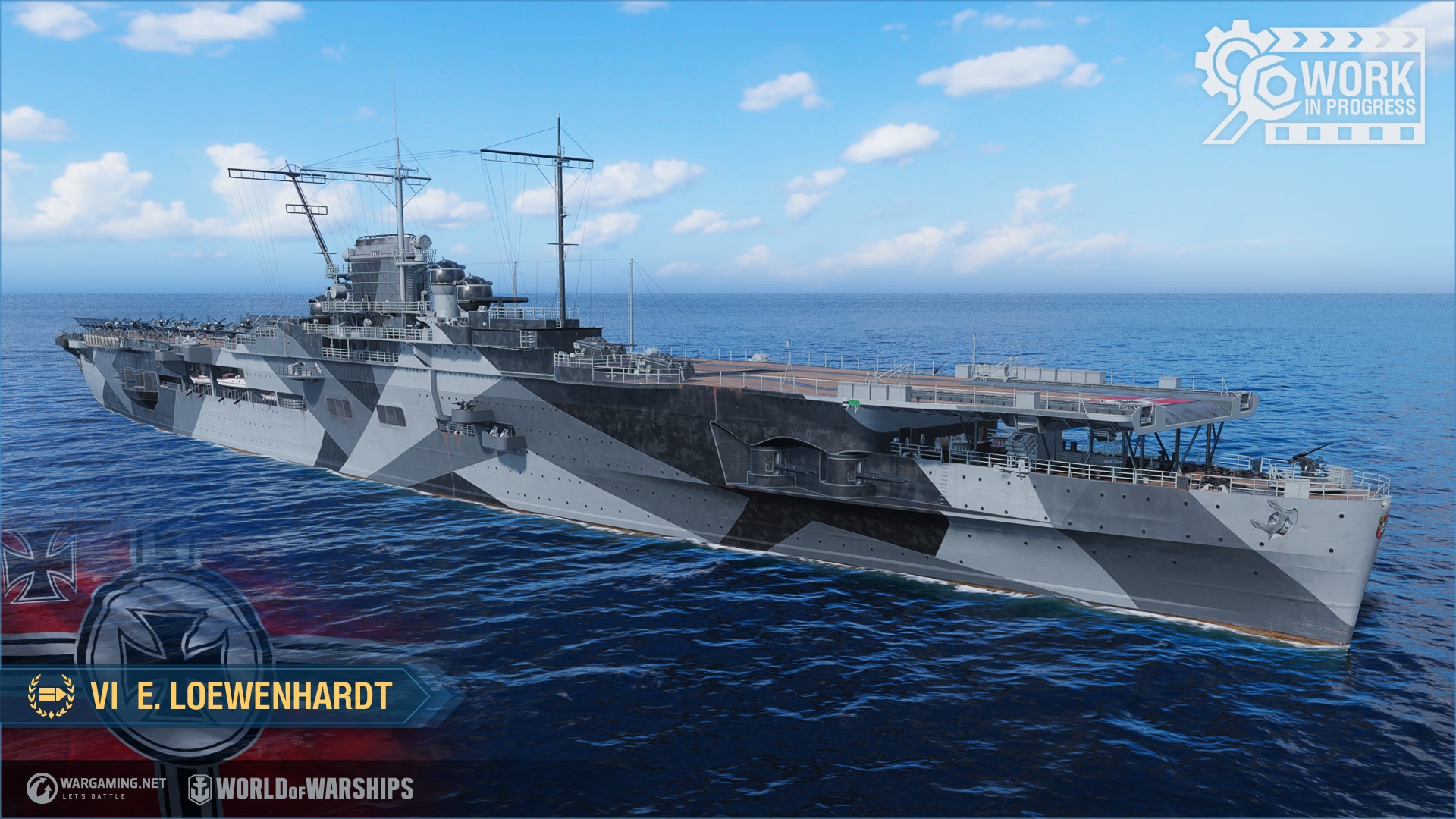
As usual, everything that you will see here is, of course, a work in progress.
![]()
Hull | Engine | Torpedo bomber | Dive Bomber | Attack Aircraft |
Erich Loewenhardt |
Propulsion: 200 000 HP |  Ju.87 C |  Ju.87 C |  Me Bf109T |
| Tier | VI |
| Health | 44 300 HP |
| Displacement | 27 750 tons |
| Aircraft on deck | |
| Attack Aircrafts | 9 |
| Torpedo Bombers | 9 |
| Dive Bombers | 9 |
| Secondary Armament | |
| Maximum Firing Range | 5.000 km |
| 105 mm L/65 Dop. L. C/31 150 mm L/55 MLC/36 | 5 x 2 105 mm 8 x 2 150 mm |
| Anti Air Defense | |
| 105 mm L/65 Dop. L. C/31 | 5 x 2 105 mm |
| 37 mm Flakzwilling 30 | 11 x 2 37 mm |
| 20 mm Flak 38 | 8 x 1 20 mm |
| Maximum speed | 35.8 knots |
| Turning Circle Radius | 1 140 m |
| Rudder Shift Time | 12.7 s |
| Surface Detectability | 13.5 km |
| Air Detectability | 10.92 km |
Attack aircraft – Me BF109T | |
| Tier | VI |
| Hit points per plane | 1 270 |
| Cruise speed | 153 knots |
| Maximum speed | 193 knots |
| Engine boost time | 5 s |
| Engine boost reload time | 10 s |
| Size of attacking flight | 2 |
| Aircraft per squadron | 6 |
| Rocket type | Sprengranate |
| Rocket caliber | 83 mm |
| Rockets per plane | 4 |
| Maximum rocket damage | 2 350 (Previously 2 150) |
| Projectile speed | 500 m/s |
| Air Drag | 0.35 |
| Projectile mass | 18 kg |
| Projectile Krupp | 2 600 |
| Projectile detonator | 0.022 s |
| Detonator threshold | 25 mm |
| Detectability range | 10.0 km |
| Aircraft restoration time | 72 s |
| Aircraft on deck | 9 |
Slot 1 | Slot 2 |
Engine Cooling  Number of Charges: 3 Work time: 10 s Cooldown: 80 s | Patrol fighter  Number of Charges: 3 Work time: 60 s Cooldown: 10 s Aircraft per squadron: 3 Patrol radius: 2.5 km |
Torpedo bomber – Ju.87 C | |
| Tier | VI |
| Hit points per plane | 1 610 |
| Cruise speed | 133 knots |
| Maximum speed | 173 knots |
| Engine boost time | 20 s |
| Engine boost reload time | 40 s |
| Size of attacking flight | 2 |
| Aircraft per squadron | 6 |
| Torpedo type | LT F5a |
| Torpedoes per plane | 1 |
| Maximum torpedo damage | 4 200 |
| Maximum torpedo range | 6.0 km |
| Torpedo speed | 32 knots |
| Torpedo arming distance | 387 m |
| Flooding chance | 23% |
| Detectability range | 10.0 km |
| Aircraft restoration time | 89 s |
| Aircraft on deck | 9 |
Slot 1 | Slot 2 |
Engine Cooling  Number of Charges: 2 Work time: 5 s Cooldown: 80 s | Patrol fighter  Number of Charges: 3 Work time: 60 s Cooldown: 10 s Aircraft per squadron: 3 Patrol radius: 2.5 km |
Dive bomber – Ju.87 C | |
| Tier | VI |
| Hit points per plane | 1 670 |
| Cruise speed | 156 knots |
| Maximum speed | 196 knots |
| Engine boost time | 20 s |
| Engine boost reload time | 40 s |
| Size of attacking flight | 2 |
| Aircraft per squadron | 6 |
| Bomb type | SC 1000 |
| Bomb per plane | 1 |
| Maximum bomb damage | 12 200 |
| Projectile speed | 470 m/s |
| Air Drag | 0.35 |
| Projectile mass | 500 kg |
| HE penetration capacity | 68 mm |
| Fire chance | 69% |
| Detectability range | 10.0 km |
| Aircraft restoration time | 84 s |
| Aircraft on deck | 9 |
Slot 1 | Slot 2 |
Engine Cooling  Number of Charges: 2 Work time: 5 s Cooldown: 80 s | Patrol fighter  Number of Charges: 3 Work time: 60 s Cooldown: 10 s Aircraft per squadron: 3 Patrol radius: 2.5 km |

| 5 x 2 105 mm L/65 Dop. L. C/31 | |
| Maximum Firing Range | 5.000 km |
| Reloading Time | 3.35 s |
| Sigma | 1.00 sigma |
| Shells | |
| Type of Projectile | HE – 105 mm Spr.Gr. Kz. |
| Alpha Damage | 1 200 HP |
| Damage | 330 HP |
| HE penetration | 26 mm |
| Explosion Size | 0.31 |
| Chance to Cause Fire | 5 % |
| Projectile Speed | 900 m/s |
| Air Drag | 0.33 |
| Projectile Mass | 15.1 kg |
| 8 x 2 150 mm L/55 MLC/36 | |
| Maximum Firing Range | 5.000 km |
| Reloading Time | 7.5 s |
| Sigma | 1.00 sigma |
| Shells | |
| Type of Projectile | HE – 150 mm Spr.Gr. L/4.5 |
| Alpha Damage | 1 700 HP |
| Damage | 670 HP |
| HE penetration | 38 mm |
| Explosion Size | 0.54 |
| Chance to Cause Fire | 8 % |
| Projectile Speed | 875 m/s |
| Air Drag | 0.33 |
| Projectile Mass | 45.3 kg |

| 8 x 2 105 mm L/65 Dop. L. C/31 | |
| Sector range | 0.1 km – 5.2 km |
| Hit chance | 100 % |
| Sector’s damage | 34 |
| Sector’s damage frequency | 0.29 s |
| Sector’s damage per second | 119 |
| Flak clouds number | 4 |
| Flak cloud damage | 1 260 |
| 11 x 2 37 mm Flakzwilling 30 | |
| Sector range | 0.1 km – 3.5 km |
| Hit chance | 100 % |
| Sector’s damage | 17 |
| Sector’s damage frequency | 0.29 s |
| Sector’s damage per second | 60 |
| 8 x 1 20 mm Flak 38 | |
| Sector range | 0.1 km – 2.0 km |
| Hit chance | 100 % |
| Sector’s damage | 17 |
| Sector’s damage frequency | 0.29 s |
| Sector’s damage per second | 60 |
Slot 1 | Slot 2 |
Damage Control Party Work time: 60 s Cooldown: 90 s | Fighter Number of charges: 4 Work time: 600 s Cooldown: 40 s Patrol Radius: 3.0 km Planes in a squadron: 4 |
The armor

The Erich Loewenhardt presents a very similar armor protection to the Graf Zeppelin and is, overall, decently protected for a tier VI carrier. For the classic reminder, in the gamemodels3d armor view, the carriers are mirrored. What should be on the starboard side is on the port side, etc.
The bow section
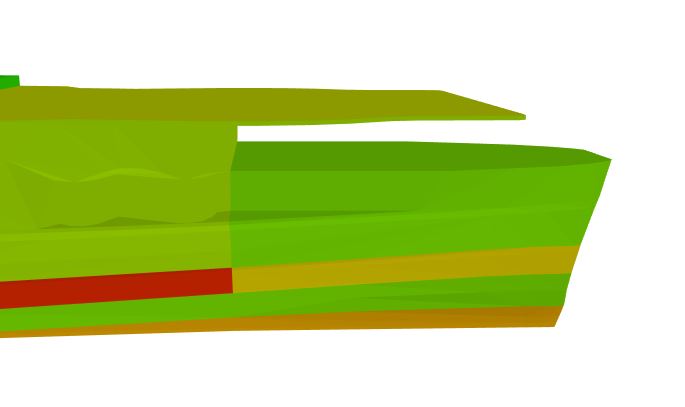
The external plating of the bow is 19 mm thick except for a small extended belt that is 25 mm thick.
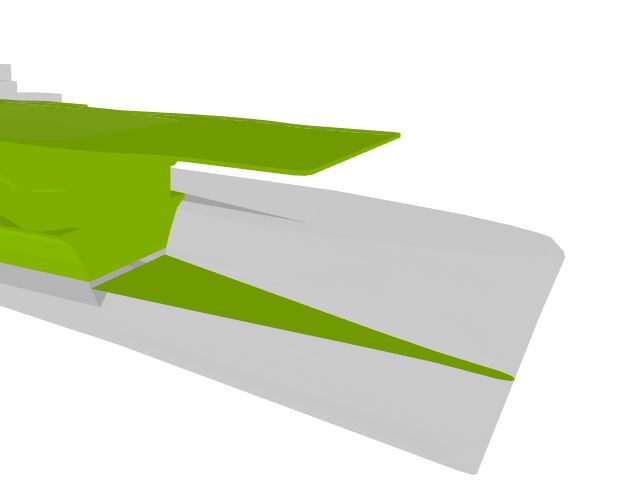
Inside the bow, there is a 20 mm armored deck at the same level as the extended belt. As you can see, the casemate protecting the hangar is also 20 mm thick.
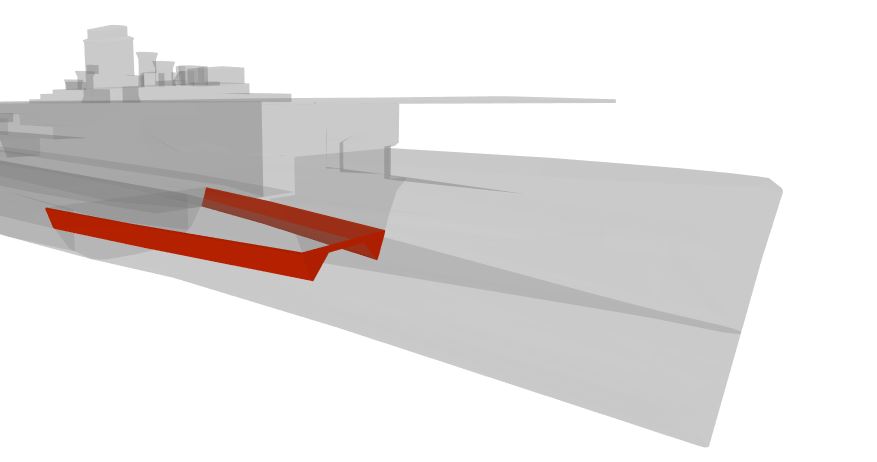
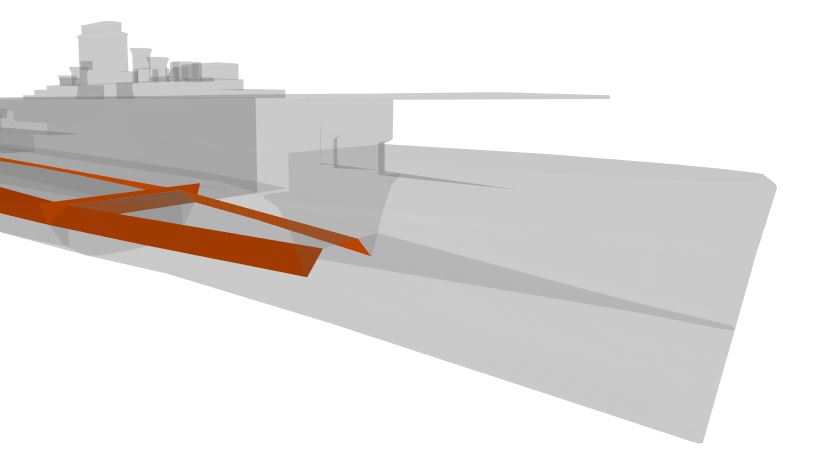
The turtleback actually starts in what is still considered as the bow. There is a 80 mm belt ending with a bulkead and right behind it, the 60 mm turtleback with a 42° to 50° slope. The upper part of the citadel’s athwartship is also 60 mm thick.
The middle section

The flight deck is 21 mm thick so this will give some form of resistance against destroyers. AP shells of a caliber of 283 mm or lower will also bounce on it if they don’t hit at a sufficient angle.
The sides are mostly protected by 20 mm of armor except where the internal hangar plating is exposed.

This internal hangar plating is 16 mm thick.



The main belt is 100 mm thick for the central part and 80 mm part on the extremities. Behind this main belt, there is the classic German turtleback with 60 mm of armor with a slope ranging from 42° to 67°. This turtleback protects the 20 mm sides of the citadel that is starting slightly above the waterline.

For the horizontal protection, below the 21 mm flight deck and a 20 mm deck that is under the hangar, she has a 40 mm main armor deck. Overall, she should be fine against AP bombs since they would trigger on the flightdeck for the carriers she could potentially face.
The stern section
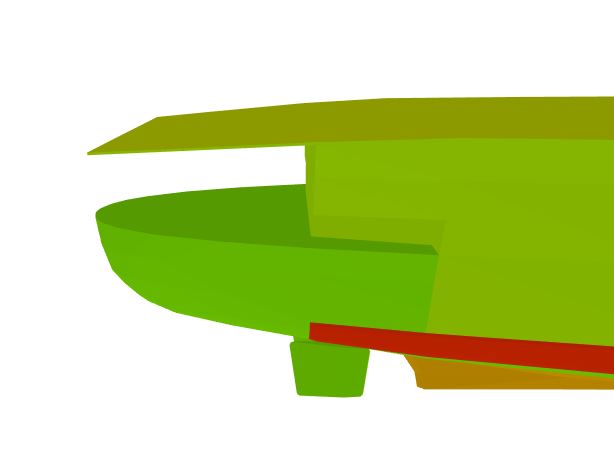
The stern is protected by 19 mm of armor except for the 80 mm belt that reaches the rudder.
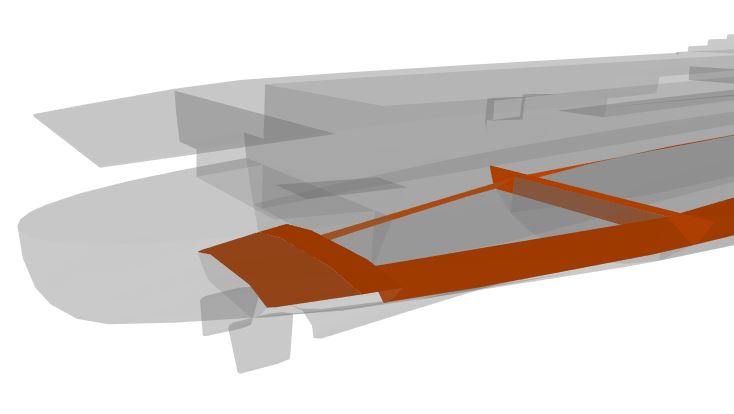
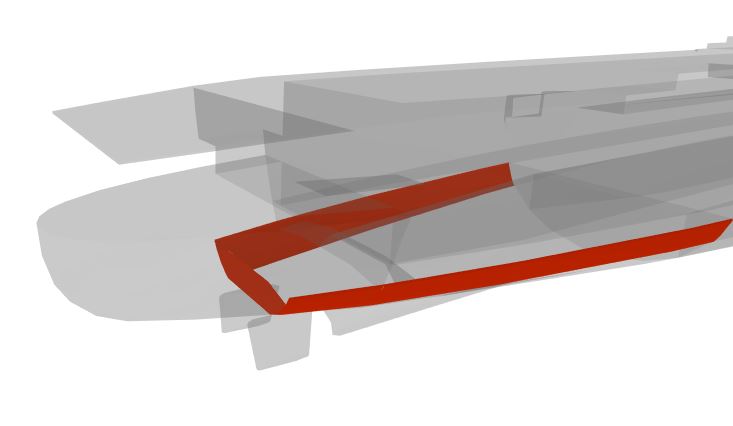
Inside the stern, there is a 60 mm armored deck, continuing the 40 mm main armor deck of the middle section. As you can see, the upper part of the rear citadel’s athwarthship is also 60 mm thick.
At the end of the armored deck, there is an 80 mm thick bulkhead protecting the steering gears.
The superstructure

The superstructure is 10 mm thick and is very similar to the one of the Graf Zeppelin, except for the funnel.
Personal Opinion
For now, the ship looks decent. I wouldn’t go as far as calling it a tier VI Saipan because the planes only have the 3rd highest health pool behind Ranger and Furious but they are very fast with only Ranger’s Wildcat having the same speed as her Me Bf109T.
As for the loadout, the bombs are definitely very good looking with their high alpha damage. The rest however isn’t really impressive. She has the small AP rockets with their limited damage and the torpedoes, while they are already more usable than the pre-buffed torpedoes of the Weser, have the lowest damage of all aerial torpedoes at tier VI as well as the lowest flooding chance with almost half of the flooding chance of other aerial torpedoes.
Overall, it looks like she will mostly rely on the bombs to get the damage done,torpedoes being the side dish and rockets being there to allow the rest to regenerate.







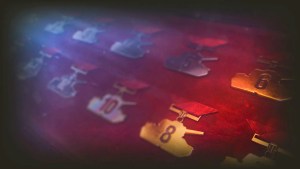

So, it is a Graf Zeppelin with planes that were actually developed for it (or, for her supposed 1941/1942/1943 configuration if the war didn’t break out and the ship was completed)? Great 🙂